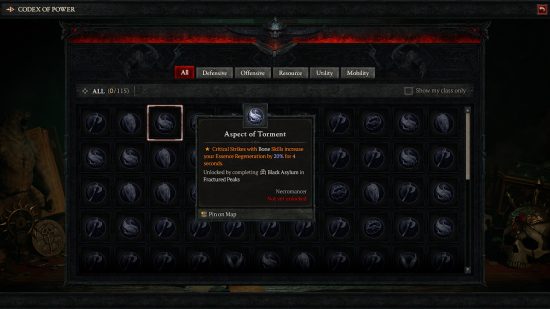How does the Diablo 4 loot system work? While we know that Diablo 4 has beautiful gothic scenarios, sprawling plains, and fast-paced action in a dark fantasy world, it’s the collection of bigger and better loot that’s the real core experience here.
The system has changed a lot since Blizzard’s new RPG game was announced, so you should learn all you can about how you can get the best gear. Due to how weapons and armor have been designed for Diablo 4, players need to farm enemies and look for better loot so they can take the most out of the skill tree. Not only are some skills tied to specific types of weapons, but legendary equipment can modify skills. If you’re looking for a way to make the most of the best classes, then you’re going to need a good set of equipment.
The Diablo 4 loot system is, of course, based on previous games, but there are some key differences. We have enough information about the game’s item progression, affixes, and a new system called the Codex of Power that unlocks the new Aspects. If you want to know more about the new D4 loot system, keep reading.

Diablo 4 item effects
As you progress through the game, looking for better loot, you will be looking for good upgrades. While this might mean finding pieces with higher numbers of important attributes to your class – Intelligence for the best Diablo 4 Sorcerer build, for instance – searching for good Affixes is just as crucial as finding a few extra points of strength.
Affixes are modifiers that each piece of equipment has, and their values are completely random. These modifiers have many effects, having three big groups of Affixes. Offensive ones that increase different aspects of your character, from stats and the efficiency of a type of damage to even the minion damage. There are also defensive Affixes that are focused on reducing damage taken, increasing the efficiency of your healing, control abilities, and barriers.

Diablo 4 item progression
Diablo 4’s loot system adheres to the same color classification the series first popularized. This tier system ranges from serviceable Normal items to build-defining Unique items, each with its own distinct number of affixes and modifiers.
You can expect item progression to generally align with your character as you work towards the Diablo 4 max level cap, though a lucky drop or two is sure to provide a welcome boost. For a full breakdown of what you can expect from your bevy of loot, check out our primer to Diablo 4 rarity levels.

Diablo 4 Unique, Sacred, and Ancient items
Just like Unique items, Sacred and Ancient items become accessible after reaching world tier three. As you complete the main campaign and finish the first two Diablo 4 world tiers, you can start the Diablo 4 endgame and have access to higher-quality items. The sacred and ancient items are improved versions of the legendary ones, meaning they roll higher numbers than the regular legendary version, making them much more powerful.
Fans of the series might be wondering about the sets of items and the mythic items. While unique items have replaced the latter, the former will only become accessible sometime after Diablo 4’s launch. As soon as we have more information, we’ll update this guide.

Diablo 4 legendary effects
Diablo 4 changes how you treat itemization and deal with the loot based on legendary effects. As explained in the previous section, legendary items have special and powerful effects. These effects aren’t limited to a singular type of item, so they may come with any item that can be equipped. If you would like to have this effect on other items, it’s possible by using the services of the Occultist, an NPC you find within Sanctuary. As explained in a Diablo 4 dev blog, by talking to them, you can destroy a legendary item to transform its effect into a legendary Aspect that can be imprinted on other legendary items. This creates single-use Aspects, so choose carefully.
The game has a new feature that allows you to permanently keep some Aspects: the Codex of Power. By completing specific dungeons, you can unlock certain legendary Aspects that are stored in your Codex of Power. This is an account-wide feature, so every one of your characters has access to all the Aspects you have, making leveling new characters an easier process. To imprint the Aspects into your rare and legendary items you need to talk to the Occultist.
Diablo 4 runewords
Runes will come in the form of either condition runes or effect runes. Condition runes, of course, set the conditions for the effect that is tacked on. Effect runes will then tell you what happens when the condition happens. Simple enough.

Needless to say, there will be hundreds of combinations available, and trying out these rune words may shape the Diablo 4 classes beyond their abilities and skills. Even though this system brings a whole new level of complexity and customization to the game, In a developer live stream, the game’s director stated that they still need more time to adjust the system, indicating that players won’t see them in the game once it is out. They haven’t given up on it and promise to return to runes and runewords in the future.
We hope this in-depth look at the Diablo 4 loot system has prepared you for your traversal into Sanctuary, but if you want more about other important features then head to our Diablo 4 transmog page. After all, you don’t need only to be powerful, but you also need to look good while killing waves of demons. Since the game’s release date is getting near, you might want to take a look at Diablo 4 system requirements and see if your PC can handle the onslaught.
